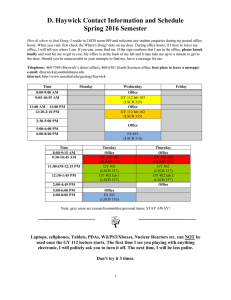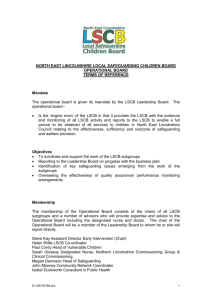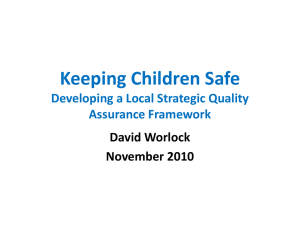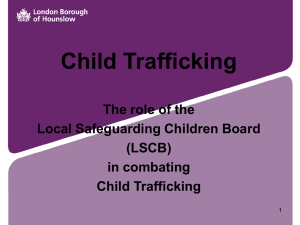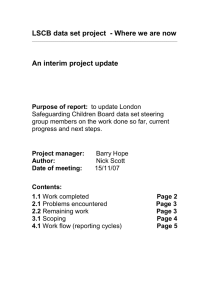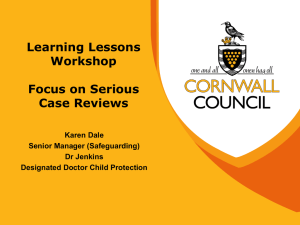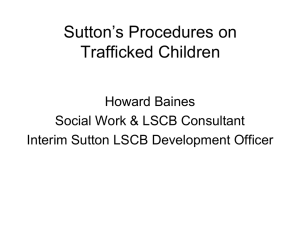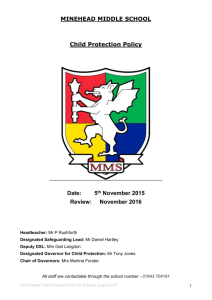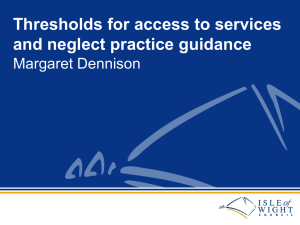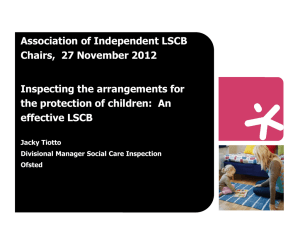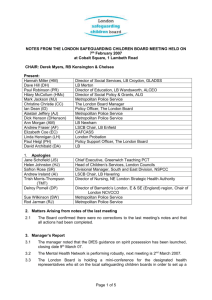Presentation - the Association of Independent LSCB Chairs
advertisement
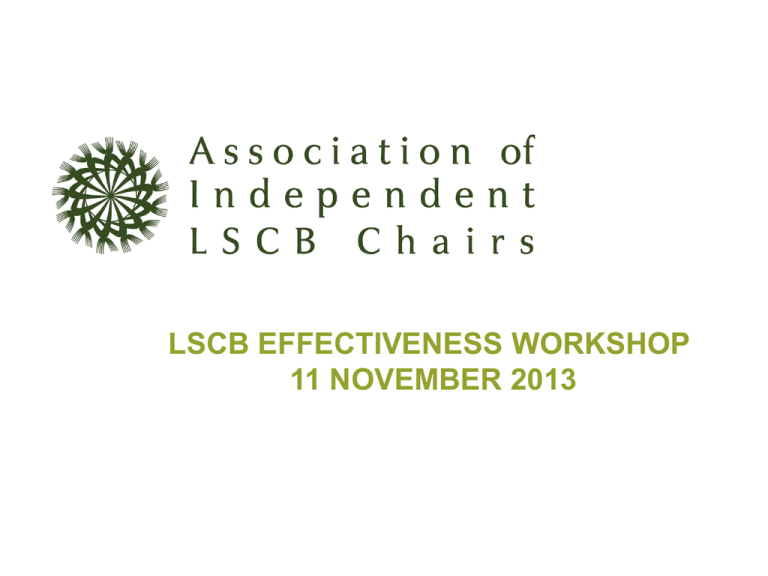
LSCB EFFECTIVENESS WORKSHOP 11 NOVEMBER 2013 Workshop Agenda 1. Background to LSCB Effectiveness Commission 2. Effectiveness Framework: Facets of an Effective LSCB 3. Content of the LSCB Effectiveness site 4. Inter-active discussion on future development of the toolkit LSCB Effectiveness Commission Aim: To develop a resource for LSCB Chairs to support Board effectiveness. • • • • Process: Research into LSCB effectiveness Analysis of guidance and regulatory frameworks Incorporation of expectations of Working Together 2013 and Ofsted LSCB Review framework Formulation of web-based toolkit to support Independent Chairs Facets of Effective LSCBs • Board Effectiveness • Quality Assurance and Performance Management • Working Together Compliance • Key Safeguarding Risk Areas Facet 1: Board Effectiveness Constitutions/TOR Member roles and responsibilities including Lay Members Relationships with other partnerships Board Effectiveness Visibility and Influence Logs of effective challenge Assessing Board Effectiveness Tools Facet 2: Quality Assurance and Performance Management How to assume a scrutiny and challenge role Quantitative Data Qualitative Data QA and PM Engagement of Front-Line Staff The Voice of the Child Readiness for Regulatory Inspection Quality Assurance and Performance Management Model QUANTITATIVE DATA (Balanced Scorecard) QUALITATIVE EVIDENCE (Programme of multi-agency audits, quality testing etc) Safeguarding Improvement Quality Assurance and Performance Management ENGAGEMENT WITH SERVICE USERS (Hearing the Voice of the Child/Young Person) ENGAGEMENT WITH FRONT LINE STAFF (Feeding in the views of staff in the identification of priorities for action) Facet 3: Working Together Compliance (1) Annual Reports Threshold Protocol Learning and Improvement Framework Single Assessment Section 11 Effective multi-agency engagement and co-ordinated Safeguarding arrangements Facet 3: Working Together Compliance (2) Role of schools and academies Role of the voluntary and community sector Independent Chair Performance Management Arrangements SCRs and other reviews CDOP Training and Development Facet 4: Current Safeguarding Issues CSE Children with Disabilities Domestic Violence Early Help and Think Family Drug and Subsistence Neglect Mental Health Front page In March 2013 the National Association of Independent Chairs commissioned a piece of work to develop a resource to support the development of effective LSCBs across the country. Since then, Ofsted has published a proposed inspection framework (July 2013) with the following definition: ‘The LSCB is likely to be outstanding if in addition to meeting the requirements for a good judgement, it provides evidence of being a highly influential strategic arrangement that directly influences and improves performance at the frontline. That improvement is sustained and extends across multi-disciplinary practice with children, young people and families. Analysis and evaluation of performance is exceptional and helps the local authority and partners to properly understand the impact of services and the areas for improvement. There is a comprehensive range of training for managers and practitioners that is directly related to multi-agency improvement priorities.’ The Facets that we have identified are set out under four key headings: Front page (2) LSCB Effectiveness Resources Board Effectiveness Quality Assurance and Performance Management Working Together Compliance Safeguarding Risk Areas Working Together 2013 Ofsted Framework for the Inspection of Child Protection 'The Evaluation of Arrangements for Effective Operation of the New Local Safeguarding Children Boards' BOARD EFFECTIVENESS Range of constitutions for Boards, executives, sub-groups, task and finish groups LSCB terms of reference Member roles and responsibilities Lay Members Working Together Compliance Resources INTRO TEXT Relationships to other partnership forums Working Together 2013 Log of effective challenge exerted by the Board Visibility and Influence Assessing Board Effectiveness LSCB Practice Exemplars LSCB Practice Exemplars Discussion • How can we secure a more extensive range of resources for the existing toolkit? • How would you want to sustain the resource in the future? • What sort of quality assurance arrangements would you want in place and how would we deliver this? • What would you identify as priority areas for development in 2014?
